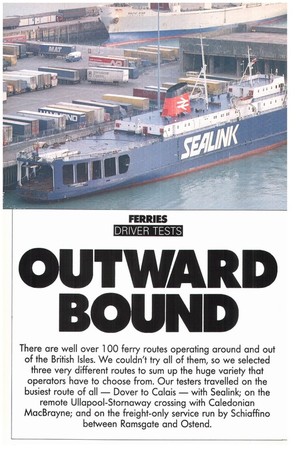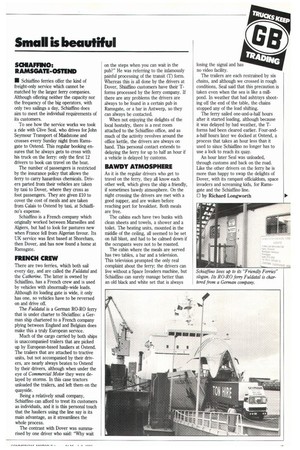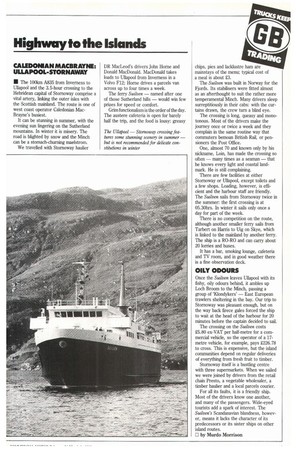OUTWARD 131:011111)
Page 48

Page 49

Page 50

Page 51

If you've noticed an error in this article please click here to report it so we can fix it.
There are well over 100 ferry routes operating around and out of the British Isles. We couldn't try all of them, so we selected three very different routes to sum up the huge variety that operators have to choose from. Our testers travelled on the busiest route of all — Dover to Calais — with Sealink; on the remote Ullapool-Stornaway crossing with Caledonian MacBrayne; and on the freight-only service run by Schiaffino between Ramsgate and Ostend.
Small is beautiful
SORAFFINO: RAMSGATE-OSTEND
• Schiaffino ferries offer the kind of freight-only service which cannot be matched by the larger ferry companies. Although offering neither the capacity nor the frequency of the big operators, with only two sailings a day, Schiaffino does aim to meet the individual requirements of its customers.
To see how the service works we took a ride with Clive Seal, who drives for John Seymour Transport of Maidstone and crosses every Sunday night from Ramsgate to Ostend. This regular booking ensures that he always gets to cross with his truck on the ferry: only the first 12 drivers to book can travel on the boat.
The number of passengers is restricted by the insurance policy that allows the ferry to carry hazardous chemicals. Drivers parted from their vehicles are taken by taxi to Dover, where they cross as foot passengers. They are given £10 to cover the cost of meals and are taken from Calais to Ostend by taxi, at Schiaffino's expense.
Schiaffino is a French company which originally worked between Marseilles and Algiers, but had to look for pastures new when France fell from Algerian favour. Its UK service was first based at Shoreham, then Dover, and has now found a home at Ramsgate.
FRENCH CREW
There are two ferries, which both sail every day, and are called the Fuldatal and the Catherine. The latter is owned by Schiaffino, has a French crew and is used by vehicles with abnormally-wide loads. Although its loading gate is wide, it only has one, so vehicles have to be reversed on and drive off.
The Fuldatal is a German RO-RO ferry that is under charter to Shciaffino: a German ship chartered to a French company plying between England and Belgium does make this a truly European service.
Much of the cargo carried by both ships is unaccompanied trailers that are picked up by European-based hauliers at Ostend. The trailers that are attached to tractive units, but not accompanied by their drivers, are nearly always beaten to Ostend by their drivers, although when under the eye of Commercial Motor they were delayed by storms. In this case tractors unloaded the trailers, and left them on the quayside.
Being a relatively small company, Schiaffino can afford to treat its customers as individuals, and it is this personal touch that the hauliers using the line say is its main advantage, as it streamlines the whole process.
The contrast with Dover was summarised by one driver who said: "Why wait on the steps when you can wait in the pub?" He was referring to the infamously painful processing of the transit (T) form. Whereas this is all done by the drivers at Dover, Shiaffino customers have their 1forms processed by the ferry company. If there are any problems the drivers are always to be found in a certain pub in Ramsgate, or a bar in Antwerp, so they can always be contacted.
When not enjoying the delights of the local hostelry, there is a rest room attached to the Schiaffino office, and as much of the activity revolves around the office kettle, the drivers are always on hand. This personal contact extends to delaying the ferry for up to half an hour if a vehicle is delayed by customs.
BAWDY ATMOSPHERE
As it is the regular drivers who get to travel on the ferry, they all know each other well, which gives the ship a friendly, if sometimes bawdy atmosphere. On the night crossing the drivers are met with a good supper, and are woken before reaching port for breakfast. Both meals are free.
The cabins each have two bunks with clean sheets and towels, a shower and a toilet. The heating units, mounted in the middle of the ceiling, all seemed to be set on full blast, and had to be calmed down if the occupants were not to be roasted.
The cabin where the meals are served has two tables, a bar and a television. This television prompted the only real complaint about the ferry; the drivers can live without a Space Invaders machine, but Schiaffino can surely manage better than an old black and white set that is always
losing the signal and has no video facility.
The trailers are each restrained by six chains, and although we crossed in rough conditions, Seal said that this precaution is taken even when the sea is like a millpond. In weather that had ashtrays shooting off the end of the table, the chains stopped any of the load shifting.
The ferry sailed one-and-a-half hours after it started loading, although because it was delayed by bad weather, the Tforms had been cleared earlier. Four-anda-half hours later we docked at Ostend, a process that takes an hour less than it used to since Schiaffino no longer has to use a lock to reach its quay.
An hour later Seal was unloaded, through customs and back on the road. Like the other drivers on the ferry he is more than happy to swap the delights of Dover, with its rampant officialdom, space invaders and screaming kids, for Ramsgate and the Schiaffino line.
0 by Richard Longworth
Ws the busiest route of all
SEALRM: DOVERCALAIS
• By far the busiest ferry route from Britain is that between Dover and Calais; the shortest sea route between Britain and the Continent.
Last year 888,981 commercial vehicles passed through Dover, and by far the greatest proportion of these travelled by the Dover-Calais route.
Despite recent hiccoughs in the service due to the seaman's strike, Commercial Motor found that drivers were generally very happy with the Sealink service.
Travelling on 15 February, we talked to truck drivers who regularly use the route, and a theme that came up continually in our conversations was how Sealink has improved its service on the route over the past two or three years.
Reliability is generally good; the route is quick and the catering is up. to standard. One nice touch on the English Sealink ferry we boarded from France to England was the announcement by the captain of all the emergency procedures — including an assurance that the bow doors were well and truly'shut before sailing!
Fred Chapman, a driver with Richard Longley from Wymondham in Norfolk, confirmed that standards on Sealink ships have risen in recent years. One anomaly concerned him, however: Prices of duty free goods on French Sealink ferries seem to remain stable, while they have risen noticeably on the British Sealink ferries.
LIMITED CHOICE
Another point made by lorry drivers using the service is that coach drivers usually embark first, and by the time the coach drivers and couriers have eaten their fill at the restaurant there is often a very limited choice for the truck drivers.
Meals on the boat are reasonably priced, though one truck driver who does not drink coffee complained that he had to pay extra for a soft drink with a meal that is advertised as including free coffee.
The drivers were less happy with the P&O service on the Dover-Calais route. One regular traveller to the Continent said he last used the P&O (then Townsend 'Thoresen) service two years ago, and he would never use it again. A particularly heartfelt complaint came from drivers who had been refused breakfasts on P&O ferries after 1 lam: "What do we want with pate?" was one heartfelt comment.
Few of the drivers we spoke to have experienced delays at Customs recently, at Dover or Calais. The introduction of the Single Administrative Document customs form seems to have passed off fairly smoothly, with few problems for drivers.
Several of the drivers we spoke to had been held up by the seaman's strike — and had little sympathy for the seaman's cause. One driver said: "I can't understand why the guys came out on strike; what do they want? More time off?" 0 by Gary Cunningham
Highway to the Islands
CALEDONIAN MACBRAYNE: ULLAPOOL-STORNAWAY
• The 100Iun A835 from Inverness to Ullapool and the 3.5-hour crossing to the Hebridean capital of Stornoway comprise a vital artery, linking the outer isles with the Scottish mainland. The route is one of west coast operator Caledonian MacBrayne's busiest.
It can be stunning in summer, with the evening sun lingering on the Sutherland mountains. In winter it is misery. The road is blighted by snow and the Minch can be a stomach-churning maelstrom.
We travelled with Stornoway haulier DR MacLeod's drivers John Horne and Donald MacDonald. MacDonald takes loads to Ullapool from Inverness in a Volvo F12; Horne drives a parcels van across up to four times a week.
The ferry Suilven — named after one of those Sutherland hills — would win few prizes for speed or comfort.
Grim functionalism is the order of the day. The austere cafeteria is open for barely half the trip, and the food is lousy: greasy The Ullapool — Stornoway crossing features some stunning scenery in summer — but is not recommended for delicate constitutions in winter chips, pies and lacklustre ham are mainstays of the menu; typical cost of a meal is about 2.3.
The Suilven was built in Norway for the Fjords. Its stabilisers were fitted almost as an afterthought to suit the rather more temperamental Minch. Many drivers sleep surreptitiously in their cabs: with the curtains drawn, the crew turn a blind eye.
The crossing is long, queasy and monotonous. Most of the drivers make the journey once or twice a week and they complain in the same routine way that commuters bemoan British Rail, or pensioners the Post Office.
One, almost 70 and known only by his nickname, Loin, has made the crossing so often — many times as a seaman — that he knows every light and coastal landmark. He is still complaining.
There are few facilities at either Stornoway or Ullapool, except toilets and a few shops. Loading, however, is efficient and the harbour staff are friendly. The Suilven sails from Stornoway twice in the summer: the first crossing is at 05.30hrs. In winter it sails only once a day for part of the week.
There is no competition on the route, although another smaller ferry sails from Tarbert on Harris to Uig on Skye, which is linked to the mainland by another ferry. The ship is a RO-RO and can carry about 20 lorries and buses.
It has a bar, smoking lounge, cafeteria and TV room, and in good weather there is a fine observation deck.
OILY ODOURS
Once the Suilven leaves Ullapool with its fishy, oily odours behind, it ambles up Loch Broom to the Minch, passing a group of alondykers' — East European trawlers sheltering in the bay. Our trip to Stornoway was pleasant enough, but on the way back firece gales forced the ship to wait at the head of the harbour for 20 minutes before the captain decided to sail.
The crossing on the Suilven costs £5.80 ex-VAT per half-metre for a commercial vehicle, so the operator of a 17metre vehicle, for example, pays £226.78 to cross. This is expensive, but the island communities depend on regular deliveries of everything from fresh fruit to timber.
Stornoway itself is a bustling centre with three supermarkets. When we sailed we were joined by drivers from the retail chain Presto, a vegetable wholesaler, a timber haulier and a local parcels courier.
For all its faults, it is a friendly ship. Most of the drivers know one another, and many of the passengers. Wide-eyed tourists add a spark of interest, The Suilven's Scandanavian blandness, however, means it lacks the character of its predecessors or its sister ships on other island routes.
O by Murdo Morrison
































































































































